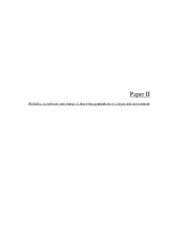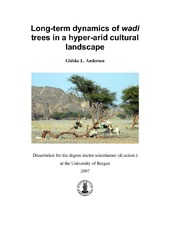| dc.contributor.author | Andersen, Gidske L. | eng |
| dc.date.accessioned | 2007-04-20T09:09:28Z | |
| dc.date.available | 2007-04-20T09:09:28Z | |
| dc.date.issued | 2007-03-09 | eng |
| dc.identifier.isbn | 978-82-308-0331-8 (print version) | en_US |
| dc.identifier.uri | http://hdl.handle.net/1956/2217 | |
| dc.description.abstract | This study focuses on the long-term dynamics of wadi (dry river valley) trees, in particular Acacia tortilis (Forssk.) Hayne, in the hyper-arid Eastern Desert of Egypt. The project was motivated by the importance of drought enduring trees for the local indigenous population, by the lack of studies on vegetation changes in hyper-arid areas, and in particular by the fact that understanding the long-term dynamics of trees is essential responding to ongoing changes effectively. Lack of data and methods offering appropriate spatial and temporal resolution has impeded research on long-term dynamics, so the use of high resolution, historical satellite data, 14C content and the anatomy of wood to obtain the necessary data is emphasised. Imagery from the first generation US reconnaissance satellite CORONA, taken already in 1965, offer a spatial (2.7 m) and temporal dimension for ecological information which other data sources cannot furnish at a comparable cost, coverage, resolution or accessibility. The vast majority of mature trees mapped in 2003 is identifiable in the imagery. A change analysis (1965-2003) reveals a negative trend in population size at most of the sites studied. Of mature trees 41 % have died. Recruitment was in general very poor at all sites, but the great capacity of saplings to resprout seems to be a major strategy to increase their persistence. A set of parameters related to water conditions, derived from the SRTM DEM, could not explain observed patterns in recruitment among sites, although it could explain some of the observed variation in mortality. Nevertheless, charcoal production seems to be the major cause of mortality. A method was developed to assure that image-based mortality estimates derived without contemporaneous reference data can be applied with great confidence. This is of particular importance when appropriate management strategies are to be adopted. The pre- and post-bomb 14C content in A. tortilis wood is used to estimate age and growth. Annual growth varies in space and time (0.2 – 2.4 mm), and the ages of the trees studied seem to lie between 200 and 650 years. In combination with the low recruitment observed, this suggests that the landscape will need very long time to recover from the ongoing and rapid deforestation. If this current trend is to be arrested, urgent action is required and must take into account the traditional management practices of the pastoral nomads who for millennia have lived in and developed sustainable strategies in accordance with local climatic conditions and available resources. | en_US |
| dc.format.extent | 7844209 bytes | eng |
| dc.format.extent | 556618 bytes | eng |
| dc.format.extent | 2611847 bytes | eng |
| dc.format.extent | 977308 bytes | eng |
| dc.format.extent | 2765319 bytes | eng |
| dc.format.mimetype | application/pdf | eng |
| dc.format.mimetype | application/pdf | eng |
| dc.format.mimetype | application/pdf | eng |
| dc.format.mimetype | application/pdf | eng |
| dc.format.mimetype | application/pdf | eng |
| dc.language.iso | eng | eng |
| dc.publisher | The University of Bergen | en_US |
| dc.relation.haspart | Paper I: Journal of Arid Environments 65(3), Andersen, G. L., How to detect desert trees using CORONA images: Discovering historical ecological data, pp. 491-511. Copyright 2006 Elsevier. <a href="http://dx.doi.org/10.1016/j.jaridenv.2005.07.010"target=_"blank"> http://dx.doi.org/10.1016/j.jaridenv.2005.07.010</a> | en_US |
| dc.relation.haspart | Paper II: Andersen, G. L. & Krzywinski, K., Mortality, recruitment and change of desert tree populations in a hyper-arid environment. Preprint. Published in PLoS ONE 2(2): e208 (2007). Copyright 2007 Andersen, Krzywinski <a href="http://dx.doi.org/10.1371/journal.pone.0000208"target=_"blank"> http://dx.doi.org/10.1371/journal.pone.0000208</a> | en_US |
| dc.relation.haspart | Paper III: Andersen, G. L., Deforestation or not – how reliable are image based mortality estimates? Accepted version | en_US |
| dc.relation.haspart | Paper IV: Andersen, G. L. & Krzywinski, K., Longevity and growth of Acacia tortilis; insights from 14C content and anatomy of wood. Preprint. Submitted to BMC Ecology. Copyright Andersen, Krzywinski | en_US |
| dc.title | Long-term dynamics of wadi trees in a hyper-arid cultural landscape | en_US |
| dc.type | Doctoral thesis | |
| dc.subject.nsi | VDP::Matematikk og Naturvitenskap: 400::Zoologiske og botaniske fag: 480 | nob |




